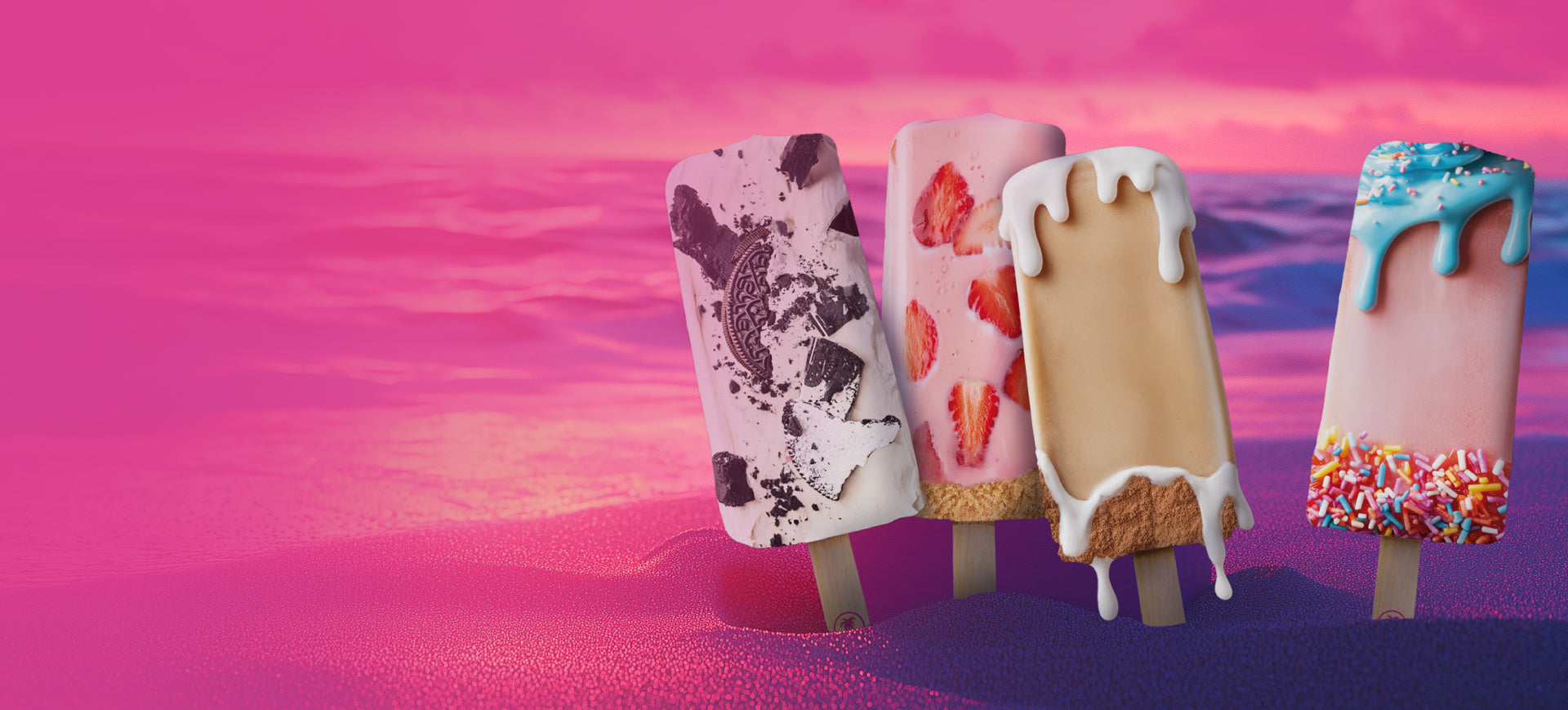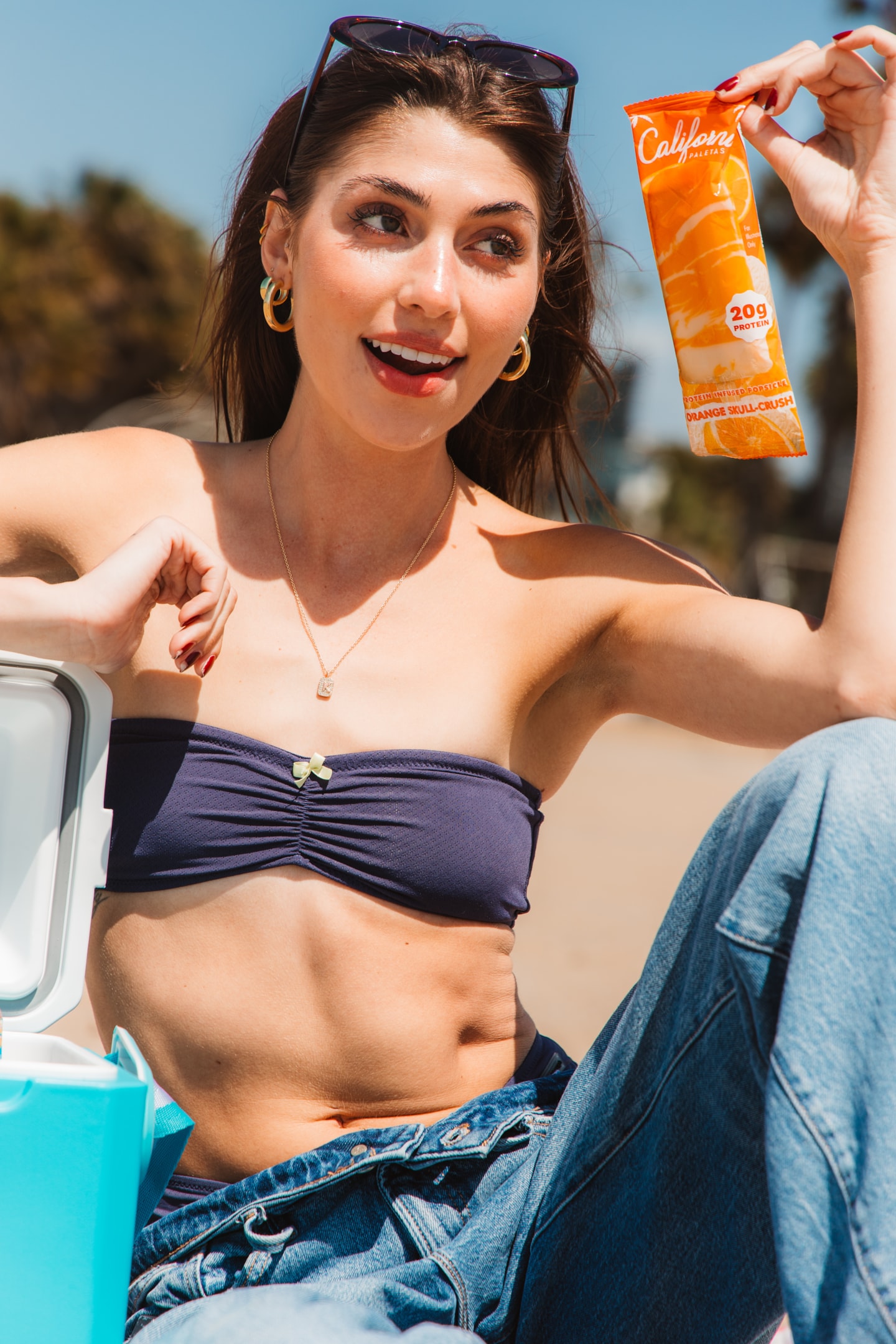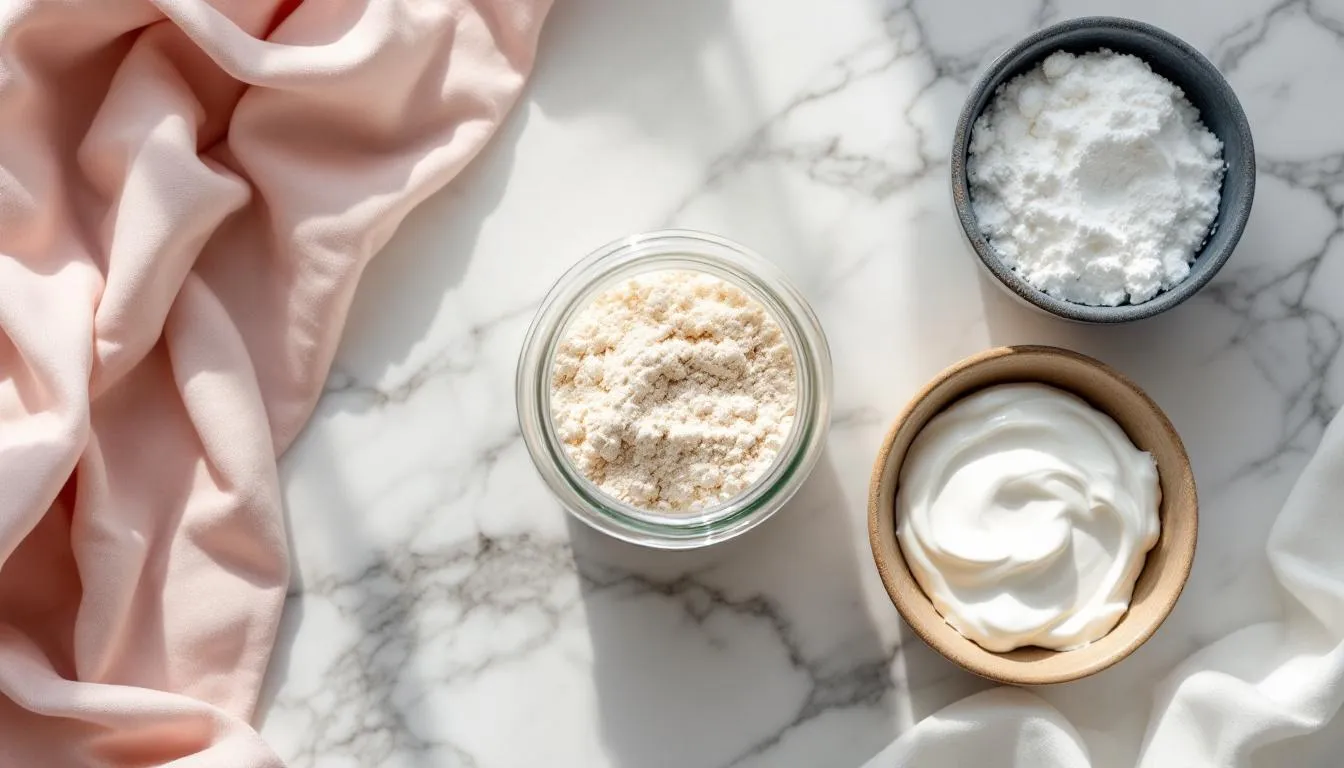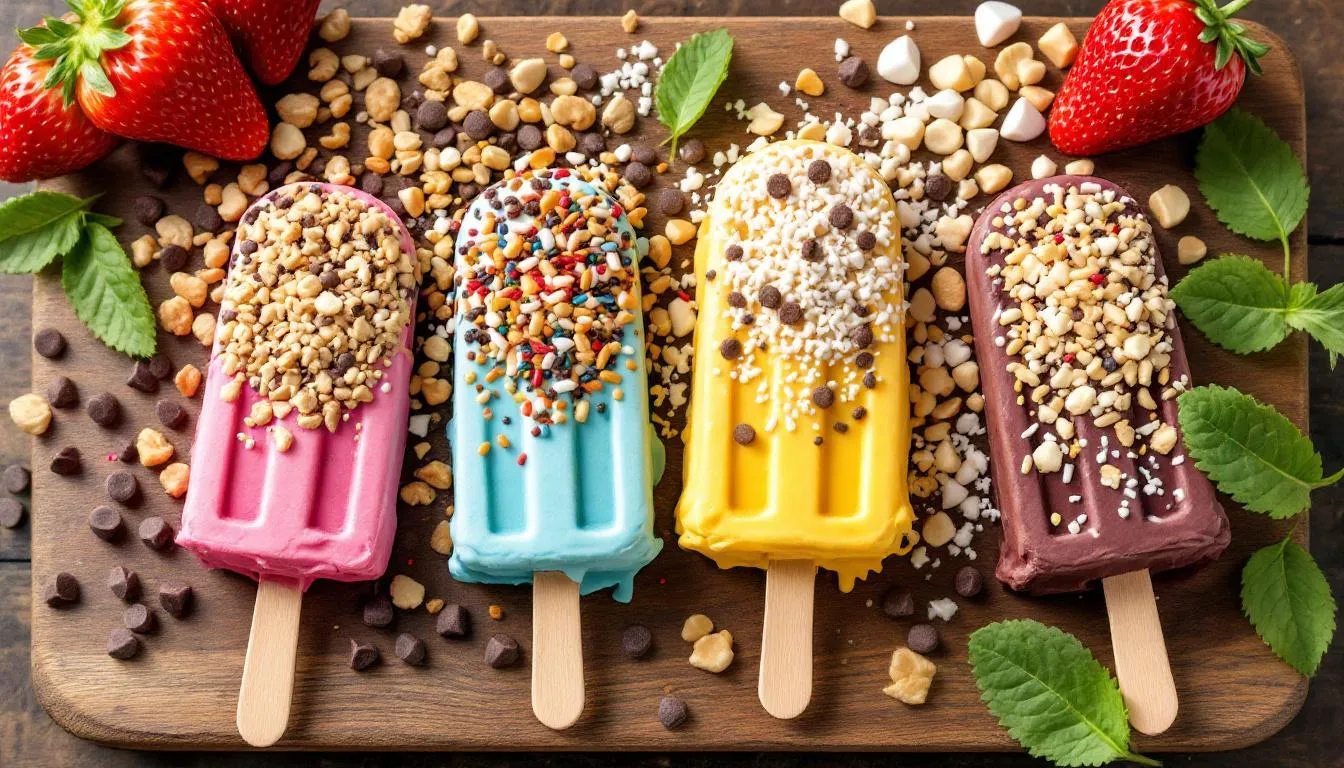

The Best Protein Ice Cream Bars: Delicious and Guilt-Free Treats

Protein Ice Cream Bars: The Ultimate High-Protein Frozen Treat
You don't have to choose between enjoying dessert and staying healthy. That's the whole point of protein ice cream bars.
But here's the thing: none of the protein content matters if the bar doesn't actually taste good. You need to feel satisfied after eating it. That craving needs to be fully met, not just partially addressed with some chalky protein bar disguised as ice cream.
The best protein ice cream bars deliver real ice cream taste with 10 to 16 grams of protein per serving. When you bite into one, you should get that creamy, indulgent experience you're craving. The protein is a bonus. The satisfaction is what matters.
California Ice Protein bars nail this balance. They taste like real ice cream because they're made with real ingredients, not artificial substitutes trying to fake it. Whether you're looking for a better dessert option, need a convenient snack between meetings, or just want something sweet in the evening, these bars actually satisfy you.
In this guide, we'll break down what makes protein ice cream bars worth buying, how to spot the ones that actually taste good, and what to look for when you're choosing bars for your freezer.
What Are Protein Ice Cream Bars?
Protein ice cream bars pack 10 to 16 grams of protein per serving into a frozen treat that tastes like the real thing. The key difference from regular ice cream bars is the base: instead of just heavy cream and sugar, quality protein ice cream bars use protein powder, greek yogurt, or coconut milk.
The formulation is where brands separate themselves. Quality protein powders like whey protein or plant based protein powder create that creamy texture you expect. Natural sweeteners like maple syrup replace refined sugar without that artificial aftertaste. The best bars feature a chocolate coating made from melted chocolate and coconut oil that gives you that satisfying snap when you bite through it.
California Ice Protein takes this approach seriously. Real ingredients that deliver on taste first, nutrition second. You can taste the difference between bars made with quality ingredients and the ones trying to cut corners with artificial flavors and sugar alcohols that leave a weird aftertaste.
These bars work for busy professionals who need a quick snack between meetings, parents looking for better dessert options, or anyone trying to make healthier choices without feeling deprived. The convenience factor matters just as much as the nutrition.
When protein ice cream bars are done right, the texture rivals traditional ice cream. Full fat greek yogurt provides creaminess while protein powder adds structure. You shouldn't have to compromise on taste to get the protein content.

Why Taste Matters As Much As Protein Content
A protein ice cream bar with 20 grams of protein is worthless if you don't enjoy eating it. The whole point is satisfaction. If you finish the bar and still feel like you need something else, it failed.
The best protein ice cream bars satisfy your craving completely. You eat one and feel done. Not deprived. Not like you need to go back for more. That's how you know you found a good one.
California Ice Protein bars deliver this satisfaction because they taste like actual ice cream. You're not eating a protein supplement shaped like a dessert. You're eating dessert that happens to have protein in it. That distinction matters.
Bad protein ice cream bars leave you disappointed. They might hit your macros on paper, but they don't satisfy the actual craving that made you open the freezer in the first place. The chalky texture, weird aftertaste, or artificial sweetener flavor reminds you that you're eating "health food" instead of real food.
Taste drives consistency. If you genuinely enjoy the bars, you'll actually keep them in your routine. They become a regular part of making better choices instead of something you force yourself to eat because "it's healthier." That's where the real value lives.
Ready to Experience Real Satisfaction?
Try California Ice Protein bars and taste the difference. Use code BLOG15 for 15% off your first order.
Shop Now & Save 15%Health Benefits of Protein Ice Cream Bars
The 10 to 16 grams of protein in each bar supports your overall health in meaningful ways. Protein helps you feel fuller longer, which makes these bars a smart choice for anyone managing their weight or trying to make better snacking decisions.
Most protein ice cream bars contain 200 to 350 calories compared to 500 or more in regular ice cream bars. That difference matters when you're trying to maintain a healthy lifestyle without feeling restricted. The protein rich ingredients and natural sweeteners replace heavy cream and excess sugar.
Protein keeps you satisfied in a way regular ice cream never does. You're less likely to go back for seconds or find yourself hunting through the pantry an hour later because the protein content helps control hunger and keeps blood sugar stable.
Many protein ice cream options work with specific dietary needs. Gluten free, dairy free, and refined sugar free varieties are available now. Whether you follow keto, paleo, or plant based eating, you can find bars that fit your lifestyle.
For anyone looking to increase their daily protein intake without relying on chicken breast and protein shakes, these bars offer a more enjoyable path. They fit into a healthy routine without feeling like a compromise.

Essential Ingredients for Homemade Protein Ice Cream Bars
If you want to make your own protein ice cream bars, start with quality protein powder. Whey protein creates the creamiest texture. Plant based protein powder works for dairy free versions. The protein powder you choose affects both taste and texture significantly.
Your creamy component determines the final texture. Full fat coconut milk provides rich consistency and natural sweetness. Greek yogurt adds tang and extra protein. Cashew cream offers a neutral base that lets other flavors shine. The fat content prevents ice crystals and ensures smooth texture.
Natural sweeteners replace refined sugar without that diet food taste. Maple syrup blends smoothly and adds subtle caramel notes. Stevia and monk fruit provide zero calorie options. Balance the sweetness with your protein powder's natural flavor.
Flavor enhancers take basic recipes to something you actually want to eat. Vanilla extract provides a classic foundation. Peanut butter powder adds richness without loading up on fat. Cocoa powder creates chocolate variations. Extracts like almond or mint open up more possibilities.
For chocolate coating, combine dark chocolate chips with coconut oil for a shell that hardens perfectly around frozen bars. This coating adds flavor and provides that satisfying crunch.
Choosing the Right Protein Powder
Whey protein creates the creamiest texture with a neutral flavor that accepts mix-ins well. It dissolves smoothly without that gritty feeling, and the complete amino acid profile supports muscle recovery effectively.
Plant based proteins work well but may need slightly more sweetener to balance earthy undertones. Pea protein offers smooth texture. Rice protein blends well with fruit flavors. Hemp protein adds nutty notes but can be grainier.
Test protein powders by mixing with liquid first. If it doesn't dissolve smoothly in a shake, it won't create smooth ice cream. Premium protein powders cost more but the results justify the price.
Flavored protein powders reduce the need for additional sweeteners and extracts. Vanilla whey protein makes an excellent base for most recipes. Chocolate protein powder creates rich bars. Unflavored options give you more versatility for creative combinations.
Step-by-Step Instructions for Making Protein Ice Cream Bars
Gather your equipment before starting: high speed blender, silicone popsicle molds, and popsicle sticks.
In your blender, combine 1 cup full fat coconut milk, 2 scoops of your chosen protein powder, 2 tablespoons peanut butter, and sweetener to taste. Blend on high for 60 to 90 seconds until completely smooth and creamy. The mixture should coat the back of a spoon.
Taste and adjust sweetness. Frozen treats taste less sweet than room temperature mixtures, so go slightly sweeter than you think. Add vanilla extract or other flavor enhancers at this stage.
Pour the mixture evenly into 6 to 8 silicone popsicle molds placed on a sheet pan for stability. Fill each mold leaving about a quarter inch space at the top for expansion during freezing. Tap the molds gently to release air bubbles.
Insert popsicle sticks into each mold. Make sure they're centered and standing straight. Place the sheet pan in the freezer for at least 6 hours or overnight. The bars are ready when completely solid throughout.
For chocolate coating, melt half a cup of chocolate chips with 1 teaspoon coconut oil in the microwave in 30 second intervals, stirring between each one until smooth. Let the chocolate cool slightly before dipping.
Remove bars from molds by gently pulling on the sticks or flexing the silicone. Dip each frozen bar in melted chocolate and let excess drip off. Add toppings like chopped nuts or sprinkles while the chocolate is still wet.
Place coated bars on parchment paper and freeze for another 30 minutes to set the chocolate shell. Let bars thaw 10 to 15 minutes before serving for optimal creamy texture.
What Makes California Ice Protein Bars Different
California Ice Protein bars focus on taste first. The protein content matters, but only if you actually enjoy eating them. These bars are formulated to satisfy your craving completely, not just meet your macros on paper.
The ingredient quality makes the difference. Real ingredients create real ice cream taste. No artificial flavors trying to fake it. No sugar alcohols leaving that weird cooling sensation in your mouth. Just clean ingredients that taste good.
The texture rivals traditional ice cream because the formulation doesn't cut corners. Premium protein sources blend with quality fats to create that smooth, creamy consistency you expect from ice cream. You shouldn't feel like you're making a sacrifice.
Each bar delivers substantial protein content while actually tasting indulgent. That balance is hard to achieve, and most brands compromise on one side or the other. California Ice Protein refuses to compromise on either.
When you finish one of these bars, you feel satisfied. Not like you need to go find something else. Not like you're still craving dessert. That's the whole point. Protein ice cream should end the craving, not just postpone it.
Other Store-Bought Protein Ice Cream Bar Options
Enlightened bars deliver 7 grams of protein per serving with rich chocolate flavor and smooth texture. Their formulation uses dairy proteins and natural flavors to create bars that taste closer to traditional ice cream while maintaining lower calorie counts.
Protein Pints stands out with 10 grams of protein per serving. Their bars feature unique flavor combinations and mix-ins that create textural interest, though some find them slightly firmer than traditional ice cream bars.
Nick's bars provide 4 grams of protein per serving but excel in chocolate taste and creamy consistency. While lower in protein than competitors, they offer flavor profiles that appeal to people prioritizing taste.
Built Bars feature 15 grams of protein with a marshmallow like texture that sets them apart from traditional ice cream bars. This unique consistency appeals to some while others prefer more conventional ice cream texture.
Quest bars deliver 12 grams of protein and are widely available in stores. Their variety of flavors and consistent quality have made them popular among fitness enthusiasts.
Price Comparison and Value
Store bought options typically cost $2 to $4 per bar, with premium brands charging more for superior ingredients and unique formulations. This pricing reflects specialized manufacturing processes and high quality protein sources.
Homemade versions cost approximately 75 cents to $1.25 per bar when you factor in ingredient costs and yield. This significant savings makes homemade production attractive for regular consumers, especially families.
Bulk purchasing and variety packs offer better value for frequent consumers. Many brands offer subscription services or multipacks that reduce per unit costs while ensuring consistent supply in your freezer.
When comparing brands, consider protein content per dollar to determine true value. A bar with 15 grams of protein at $3 offers better protein value than a 7 gram protein bar at $2.50, especially if you're prioritizing nutritional benefits.
Flavor Variations and Creative Add-Ins
Chocolate peanut butter combinations create bars people actually crave by adding 2 tablespoons peanut butter powder and cocoa powder to your base recipe. This classic pairing delivers rich flavor while maintaining high protein content.
Strawberry cheesecake bars blend fresh strawberries with cream cheese for tangy sweetness. Use freeze dried strawberries for concentrated flavor without excess moisture. Add a small amount of cream cheese for authentic cheesecake taste.

Mint chocolate chip variations add peppermint extract and mini chocolate chips for refreshing coolness. Start with a quarter teaspoon of peppermint extract and adjust to taste. This flavor intensifies when frozen, so less is more.
Cookies and cream bars incorporate crushed sugar free cookies for textural contrast. Pulse cookies in a food processor to create various sized pieces, then fold into the mixture just before freezing to maintain crunch.
Tropical coconut bars use coconut protein powder and shredded coconut for vacation inspired treats. Add lime zest and a small amount of pineapple extract for authentic tropical flavor.
Equipment Needed for Homemade Protein Ice Cream Bars
A high speed blender or food processor ensures smooth mixing of all ingredients and prevents graininess that ruins the final texture. Standard blenders may leave protein powder lumps, so quality equipment matters.
Silicone popsicle molds in 6 to 8 cavity sizes work well for standard serving portions. Silicone releases bars easily and withstands freezer temperatures without cracking. Choose molds with straight sides for even coating when dipping in chocolate.
Wooden popsicle sticks or reusable plastic sticks provide handles for easy consumption. Wooden sticks are traditional and disposable. Plastic options can be washed and reused for a more environmentally friendly approach.
A sheet pan holds molds steady during freezing and provides easy transport to and from the freezer. Choose a pan that fits comfortably in your freezer with adequate clearance above the molds.
Small microwave safe bowls are essential for melting chocolate coating safely and efficiently. Glass or ceramic bowls distribute heat evenly and prevent chocolate from burning.
Parchment paper facilitates easy cleanup during chocolate dipping and prevents bars from sticking to surfaces. Pre cut sheets save time and ensure adequate coverage for the coating process.
Storage and Serving Tips
Store finished bars in freezer safe containers or zip top bags to prevent freezer burn and maintain optimal texture. Proper storage prevents ice crystal formation and preserves the creamy consistency.
Consume within 1 month for best taste and texture. Extended freezer storage can affect flavor and mouthfeel. Label containers with preparation dates to track freshness and ensure you enjoy bars at their peak quality.
Thaw bars 10 to 15 minutes before eating for the creamiest consistency. This brief thawing period allows the texture to soften slightly while maintaining structural integrity.
Wrap individual bars in parchment paper to prevent sticking when stored together. This separation method makes grabbing single servings convenient while protecting the chocolate coating from damage.
Label containers with flavor and date information for easy identification when you have multiple varieties in your freezer. This organization helps you rotate stock and choose flavors based on current cravings.
Dietary Modifications and Substitutions
Dairy free versions use coconut milk, almond milk, or plant based yogurt as the creamy base. These alternatives provide similar richness while accommodating lactose intolerance or vegan preferences. Coconut milk offers the richest texture while almond milk creates lighter bars.
Low carb modifications use stevia or monk fruit instead of traditional sweeteners. These zero calorie options maintain sweetness without affecting ketosis or blood sugar levels, making the bars suitable for ketogenic or diabetic diets.
Nut free versions substitute sunflower seed butter for peanut butter and provide similar richness and flavor complexity. Seed butters offer comparable nutrition profiles while eliminating common allergen concerns.
Paleo friendly recipes use collagen protein and natural sweeteners exclusively and avoid all processed ingredients. Collagen protein provides different amino acid profiles and may offer additional skin and joint benefits beyond muscle support.
Vegan options combine plant based protein powders with coconut milk for completely animal free treats. Choose protein powders made from pea, rice, or hemp for optimal texture and complete amino acid profiles.
Frequently Asked Questions
Can I use regular yogurt instead of Greek yogurt?
Yes, but the texture will be less creamy and more icy due to higher water content. If using regular yogurt, strain it through cheesecloth for 2 to 4 hours to remove excess liquid and concentrate the protein content.
Why are my bars too hard?
Extended freezing or insufficient fat content creates overly firm bars. Allow longer thawing time of 15 to 20 minutes or add more liquid ingredients like coconut milk to your next batch for improved texture.
How long do homemade bars last?
Properly stored homemade protein ice cream bars maintain quality for up to 1 month in the freezer. After this period, ice crystals may form and flavors may diminish, though the bars remain safe to eat.
Can I make bars without molds?
Yes. Freeze the mixture in a lined pan and cut into bar shapes once solid. Use a sharp knife dipped in warm water for clean cuts and insert sticks after cutting for easier handling.
What if my bars are too soft?
Increase protein powder content or reduce liquid ingredients in your next batch. Soft bars typically result from too much liquid or insufficient protein to create proper structure during freezing.
The protein content and natural stabilizing properties of quality ingredients ensure your bars achieve the perfect balance of creaminess and firmness. Experiment with ratios to find your ideal texture preference.
The Bottom Line on Protein Ice Cream Bars
Protein ice cream bars work when they satisfy your craving completely. The protein content is meaningless if you finish eating and still want something else. That's why taste matters more than the numbers on the nutrition label.
California Ice Protein bars prove you don't have to compromise. Real ice cream taste with better nutrition. When you find bars that deliver both, they become something you genuinely look forward to instead of just another healthy swap you're forcing yourself to make.
Whether you buy ready made bars or make your own at home, the goal stays the same: complete satisfaction. Find the bars that genuinely end your craving, and you've found the right ones. That's how healthy choices become sustainable choices.
Get Your Protein Ice Cream Bars Delivered
Build your custom 6-box bundle and discover why California Ice Protein bars are the best choice for real satisfaction.
Build Your Bundle Now



